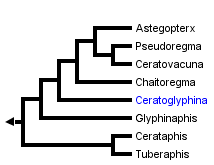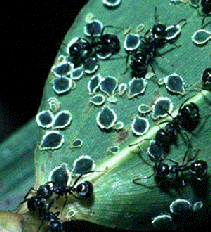Cerataphidini
David L. Stern


This tree diagram shows the relationships between several groups of organisms.
The root of the current tree connects the organisms featured in this tree to their containing group and the rest of the Tree of Life. The basal branching point in the tree represents the ancestor of the other groups in the tree. This ancestor diversified over time into several descendent subgroups, which are represented as internal nodes and terminal taxa to the right.

You can click on the root to travel down the Tree of Life all the way to the root of all Life, and you can click on the names of descendent subgroups to travel up the Tree of Life all the way to individual species.
For more information on ToL tree formatting, please see Interpreting the Tree or Classification. To learn more about phylogenetic trees, please visit our Phylogenetic Biology pages.
close boxIntroduction
The Cerataphidini are a group of approximately 80 species of aphids divided into eight genera. The cerataphidine aphids have attracted considerable interest from evolutionary biologists because all species produce sterile defender morphs within their galls. In addition, many species of the genera Ceratovacuna and Pseudoregma produce highly specialized horned soldiers on the secondary host (reviewed in Aoki 1976; Stern and Foster 1996).Discussion of Phylogenetic Relationships
This phylogeny was constructed on the basis of the results of Stern (1994, 1995) and Fukatsu et al. (1995). Fukatsu et al. group Glyphinaphis with Cerataphis and Tuberaphis on the basis of one morphological character, the presence of yeast-like endosymbionts. However, the results of the molecular phylogenetic study by Stern (1994) support the placement of Glyphinaphis shown here. In addition, further unpublished results of Stern, Aoki and Kurosu support this placement. However, the positions of Glyphinaphis, Cerataphis, and Tuberaphis are still problematical and it is likely that all three genera arose early in the history of the tribe.The monophyly of Astegopteryx, Pseudoregma, Ceratovacuna, Chaitoregma, and Ceratoglyphina are very strongly supported by the results of Stern (1994, 1995) and Stern, Aoki and Kurosu (unpublished).
Geographic Distribution
The Cerataphidini are unusual among aphids because many of the species live in the Asian tropics, whereas most aphid species are found in the northern temperate regions. Cerataphidine aphids can be found from North-Eastern India through China and Japan. Their northern limit appears to be Korea and northern Japan, and they can be found throughout much of Southeast Asia, through to Java. However, they are apparently rare in Sulawesi and the Phillipines, and presumably in the more easterly islands and Papua-New Guinea.Host Plants
Primary Host Plants: Species of the genus Styrax (Styracaceae).Secondary Host Plants: Typically Graminae, Loranthaceae, Palmae, or Zingiberaceae, but some species are also found on the Araceae, Balsaminaceae, Compositae, and Pandanaceae.
The ancestral state is apparently host alternation between trees of Styrax and the secondary host. However, many species have lost either the primary or the secondary host. Loss of the primary host is more common.
References
Aoki, S. 1987. Evolution of sterile soldiers in aphids. In Animal Societies: Theories and Facts. Y. Itô, J. L. Brown, and J. Kikkawa, eds., pp. 53-65. Tokyo: Japan Sci. Soc. Press.
Stern, D. L. 1994. A phylogenetic analysis of soldier evolution in the aphid family Hormaphididae. Proc. R. Soc. Lond. B. 256:203-209.
Stern, D. L. 1995. Phylogenetic evidence that aphids, rather than plants, determine gall morphology. Proc. R. Soc. Lond. B. 260:85-89.
Stern, D. L. and W. A. Foster. 1996. The evolution of soldiers in aphids. Biol. Rev. in press.
Fukatsu, T., S. Aoki, U. Kurosu, and H. Ishikawa. 1994. Phylogeny of Cerataphidini aphids revealed by their symbiotic microorganisms and basic structure of their galls: implications for host-symbiont coevolution and evolution of sterile soldier castes. Zoological Sciences 11:613-623.
Title Illustrations

A colony of Astegopteryx formosana on a bamboo leaf being tended by ants, Taiwan. Photograph copyright © 1995, David L. Stern.
| Scientific Name | Astegopteryx formosana |
|---|---|
| Location | Taiwan |
| Comments | A colony of Astegopteryx formosana on a bamboo leaf being tended by ants |
| Image Use |
 This media file is licensed under the Creative Commons Attribution License - Version 3.0. This media file is licensed under the Creative Commons Attribution License - Version 3.0.
|
| Copyright |
© 1995 David L. Stern

|
About This Page
David L. Stern

Princeton University, Princeton, New Jersey, USA
Correspondence regarding this page should be directed to David L. Stern at
Page copyright © 1995 David L. Stern
 Page: Tree of Life
Cerataphidini.
Authored by
David L. Stern.
The TEXT of this page is licensed under the
Creative Commons Attribution License - Version 3.0. Note that images and other media
featured on this page are each governed by their own license, and they may or may not be available
for reuse. Click on an image or a media link to access the media data window, which provides the
relevant licensing information. For the general terms and conditions of ToL material reuse and
redistribution, please see the Tree of Life Copyright
Policies.
Page: Tree of Life
Cerataphidini.
Authored by
David L. Stern.
The TEXT of this page is licensed under the
Creative Commons Attribution License - Version 3.0. Note that images and other media
featured on this page are each governed by their own license, and they may or may not be available
for reuse. Click on an image or a media link to access the media data window, which provides the
relevant licensing information. For the general terms and conditions of ToL material reuse and
redistribution, please see the Tree of Life Copyright
Policies.
Citing this page:
Stern, David L. 1995. Cerataphidini. Version 01 January 1995 (under construction). http://tolweb.org/Cerataphidini/11051/1995.01.01 in The Tree of Life Web Project, http://tolweb.org/







 Go to quick links
Go to quick search
Go to navigation for this section of the ToL site
Go to detailed links for the ToL site
Go to quick links
Go to quick search
Go to navigation for this section of the ToL site
Go to detailed links for the ToL site